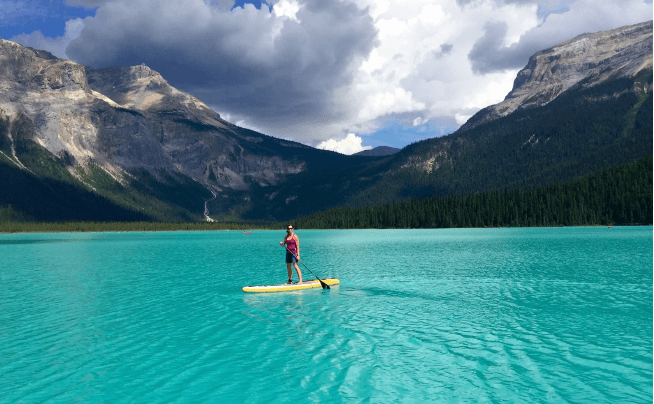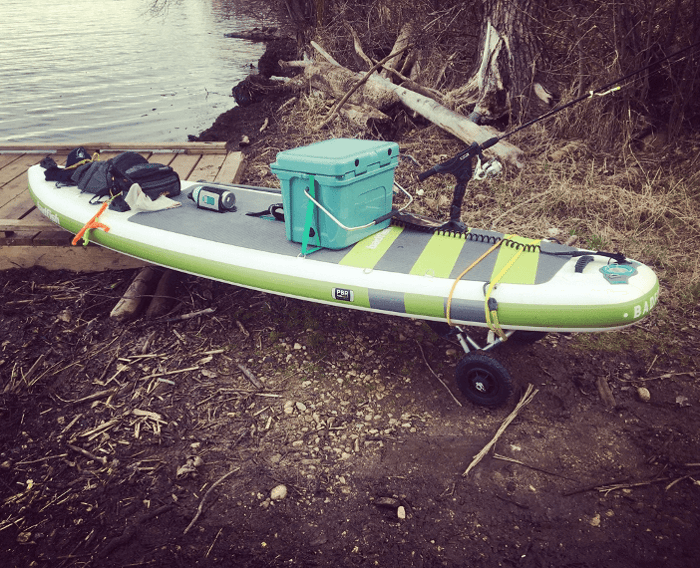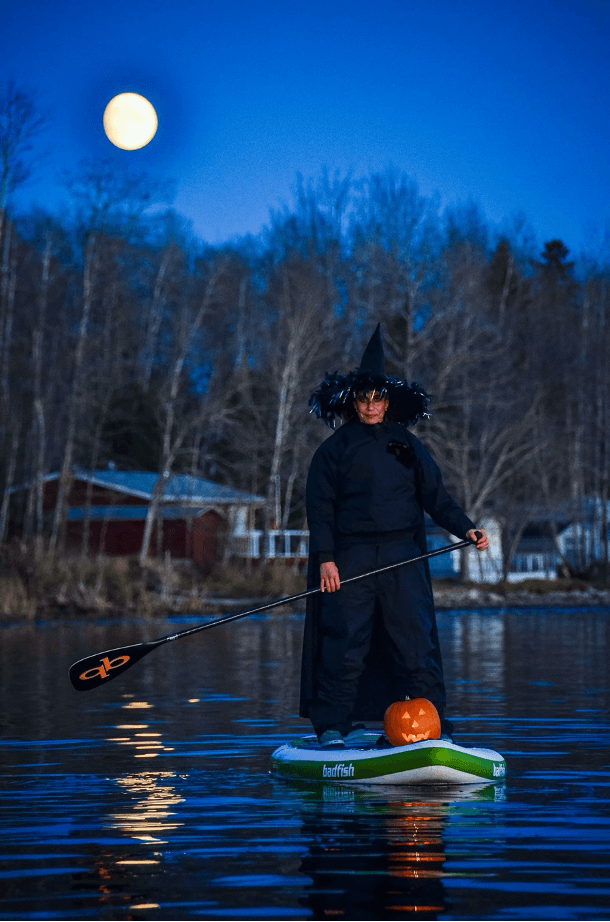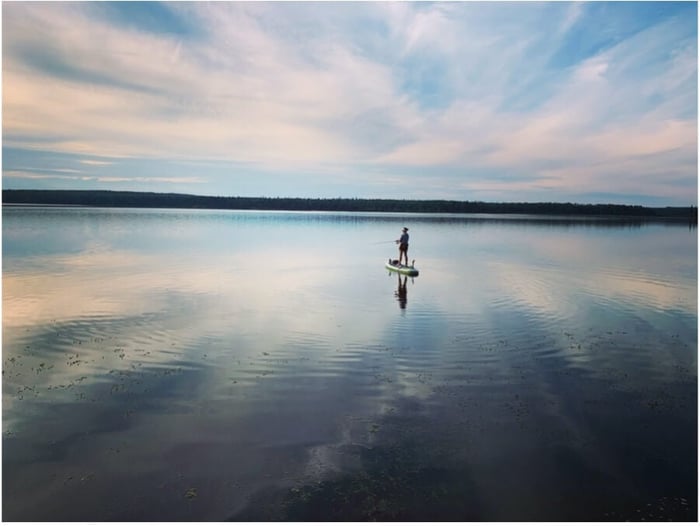WALKING ON WATER
Stand up paddle boarding (SUP) is one of the fastest growing sports in the world and as a beginner SUP you have plenty to look forward to.
For most of us, our first SUP experience will be on a lake, aka flatwater. These waterbodies do not have a current in them like a river or ocean.
Being a stand up paddle board instructor for over five years I’ve had the pleasure of paddling in some stunning areas of the world.

Emerald Lake, BC
In this article I’ll give you a base understanding of what this sport’s about.
Complete Beginner Guide to Flatwater SUP
Stand Up Paddleboard History
Where SUP Started
Modern day stand up paddling originated in Waikiki in the 1940’s as surf instructors began to carry paddles to position themselves better to watch students and take photos of them. As the sport morphed into its own niche, surfboard companies started producing stand up paddle boards.
Today, there are many stand up paddle board companies worldwide designing and producing various types of SUP’s.
FLATWATER SUP GEAR

Flatwater SUP’s shapes are flatter when compared to other styles of boards such as Whitewater SUP.
Board Parts
Nose: front of board
Tail: back of board
Rails: sides of board
Deck Pad: soft mat on top
Carry Handle: middle of board, best balance point
Fins: Either one or multiple fins on the bottom to use for tracking
SUP Board Size Matters
Boards range in length from 9-14’. Width can be 25-32”. These are large parameters and each one can serve a unique purpose, depending on intent.
For general paddling enjoyment, a paddle board 10-11ft long and 30-32” is sufficient.
The bigger the board the more stability you’ll have.
This is especially true for tall paddlers--their higher center of gravity makes it more challenging to stand on a small board. Buying a board from an expert dealer such as AQ Outdoors ensures you’ll get the best paddle board for your needs.
Inflatable or Hard Stand Up Paddleboard?
Another consideration is purchasing an inflatable or hard board.
Racing boards are built from fibreglass/epoxy to glide and move faster in the water. Non-racing hard boards come in many shapes and sizes. They are great boards with limitations, such as chipping and denting.
Plastic boards are produced by some companies. They are heavier than most boards.
For someone buying a board to enjoy with their kids or to travel with, the inflatable is the most versatile. Inflatables are close to indestructible: if you ram into a dock they don’t chip. If you’re flying somewhere or have a small car they’re easy to fold up and move around.
It’s important to keep your inflatable SUP out of direct sun to avoid over inflation as the air expands. Bleeding out a little air will also prevent this.
All stand up paddleboards should be flipped deck pad down to avoid the sun’s damaging UV rays from degrading the soft matting on the top.
SUP Maintenance

Cleaning your board and storing it out of the elements is crucial to enjoying your board for years to come.
Wash off any mud or dreaded poplar tree resin quickly to avoid staining. All you need is warm water and a soft brush. Mr. Clean erasers work on stains.
If your board has a removable fin take it off and clean the fin box--this is the only area on a SUP that can transfer invasive species into another waterbody. Should you pass a boat inspection station, you are required to show them your board. It is a watercraft.
Stand Up Paddle, not Oar

As paddle boarders we use the term paddle instead of oar.
There are four main parts to the paddle:
- T-Grip: top handle shaped like a T
- Shaft: the long section of the paddle
- Throat: narrow section closest to the blade
- Blade: wide bottom section of paddle
Types of Stand Up Paddles
The type of paddle you choose depends on what type of paddling you do. Many paddles that come standard with packages suffice for recreational paddling on a hot summer day.
Materials range from plastic, carbon, fibreglass and aluminum. The paddle above is a carbon ultra-lightweight one-piece custom cut length. I use it for long paddles of up to 90 km a day.
The larger the paddle blade the more difficult it may be for a smaller paddler to move, which will lead to increased fatigue. This is a personal choice with many options. Contacting AQ Outdoors is the best way to find the right paddle for you.
An average beginner stand up paddle will be adjustable, have a medium sized blade size and be made of aluminum or fiberglass.
Sizing your paddle is done by gripping the shaft with one hand, the T-grip with the other, holding it overhead and having both elbows at approximately 90 degrees. Move the adjustment up or down until this is achieved. This is also where your hands should be on your paddle as you use it on the water.
WHAT TO WEAR ON YOUR SUP

Pups and SUP’s enjoying some flatwater fun in the summertime!
Clothing is dependent on your surroundings and weather.
If you’re a recreational paddler wanting to enjoy a hot summer day on the lake, the standard is a bathing suit with PFD/whistle and throw rope on board.
If you’re an all-season paddler a dry suit is in order, with appropriate footwear.
I paddle fully clothed. Avoiding cotton is important—this material draws heat away from your body if it gets wet.
There are so many affordable athletic clothing options nowadays you should be able to transition gym clothing to paddle clothing. Polyester and merino wool are what I prefer.
Footwear is a personal choice; many people go barefoot which is suitable in summer.
Sandals, Crocs, water shoes and light running shoes all work. Wearing a shoe can prevent your feet cramping, which is a common beginner stand up paddler problem. My favourite is the Astral Brewess 2.0 Shoe.
Consider taking your shoes on your board in case something happens and you have to walk back along shore. I know I’m not the same as when I was a kid and could walk barefoot anywhere; ouch!
BEGINNER SUP TECHNIQUE
Paddle Strokes

The most commonly used strokes on flatwater are the forward and sweep stroke.
The forward stroke involves reaching ahead with your top hand on the T-grip and bottom hand on the shaft (thumb up towards your head). Planting the paddle deep into the water and taking the paddle out at your feet.
As pictured, the most common faux pas is holding the paddle wrong. To efficiently move yourself across the water your blade should point away from you.
The sweep stroke is a quick way to move the nose of the board around. Bend deep, squat low, reach your blade to the nose and draw a 45 degree arc away from your board.
Keeping your board straight is one of the most frustrating and challenging skills to learn in SUP. This is where an instructor can be invaluable in providing you feedback and technique cues.
Mounting Your SUP
To safely get on your stand up paddle board there are two ways. From shore or from a dock; both will be from your knees.
When on shore, walk out into the water until it's at knee depth. This ensures your fin will not touch the bottom and potentially get damaged. Your nose should point away from land, toward the water. The carry handle is the best point of balance and where you’ll straddle the board on your knees. Place your paddle horizontally across the board when you get on.
Paddle on your knees: once you’ve paddled out to a depth that is deeper than your height (so you don’t hurt yourself on the lakebed if you fall off) and stand up when you’re ready.
Docks present a challenge: they are the one place you can get really hurt if you fall off your paddle board and hit the dock! Always leave and return to the dock on your knees to avoid injury.
Sit or kneel on the edge of the dock, place your paddle either on the board or keep it in your hand, and position yourself kneeling at the carry handle.
Paddle away from the dock until it is safe to stand. Be aware of strong winds which may push you back to the dock. Take note of your surroundings and point your nose away from any hazards as you prepare to stand.
Standing on your SUP is nearly always with feet on either side of the carry handle. This is the centre of the board and will distribute your weight evenly. Think soft knee bend, strong core and off you go!
BEGINNER SUP SAFETY
Anytime you’re on the water with your paddle board the following requirements must be met.
TRANSPORT CANADA LAW REQUIRES:
A PFD, WHISTLE, AND a 15 M BUOYANT THROW LINE.
PFD’s offer buoyancy if you fall off and become too tired or unable to keep swimming. A whistle is used as a communication tool to alert others that you or someone else needs help.
If you’re not wearing your PFD and whistle on your person, you then need a 15 m throw line on the board as well. This can be used to assist someone if they’ve lost their board or require you to help pull them to safety. You should practice these skills so you don’t become the person requiring rescue while helping someone else.
If possible, especially when learning, avoid paddling alone. Friends make everything more fun and you have someone who can assist you if anything goes wrong. Getting onto a flipped board cold and tired is harder than when you’re fresh and warm.
LEASH

This young lad has his leash on, even though I’m close and helping him.
LEASH IT OR LOSE IT! ALWAYS WEAR A LEASH ON FLATWATER--IT’S NOT LAW, BUT IT IS LIFESAVING!
A leash keeps you attached to the giant floating board so you’re safe and able to get out of the water. This helps avoid drowning and hypothermia.
Leashes often do not come standard with a board and you need to purchase one separately. Although, this is changing and many boards now come with one.
On flatwater you’ll wear your leash on your ankle, ensuring it’s tight enough to not fall off your foot if you enter the water.
The decision between a coiled or straight leash is a personal preference. Many flatwater SUPs have coiled leashes, as they are easier to manage while standing on the deck pad.
PADDLE BOARD SMARTER
As paddle boarders we have a responsibility to keep ourselves safe on the water, which involves not putting ourselves into high risk situations.
Remember the 10/30 rule of boating:
Boats must legally drive 10 km/hr within 30 m of shore (100 ft). This prevents large wakes and interfering with other watercraft/swimmers.
This is your safe place to paddle for two reasons: boating traffic is slower and as a paddle boarder we are going to see the most wildlife close to shore.
I’ve paddled over fish spawning in April on my board, past loons nesting and watched pelicans chase off a bald eagle, all within 100 ft. of shore.
Stay Out of the Way
Yes, you have the right to paddle into the middle of the lake on a long weekend with hundreds of wakeboard boats, but you are a hazard. Is it appealing to bike into rush hour traffic on a freeway? Same idea: you have the right but personal safety should be number one!
The reflection of the sun shining on a lake can make it hard to see small watercraft if you’re in a large boat. Keep yourself visible and do not be afraid to wave your paddle if you think someone isn’t aware you’re in their path.
If you want to explore across open water, perhaps waking up early is a wise choice. There’s less boat traffic and more wildlife.
Paddle Boarding Where the Wind Blows
On flatwater we are at the mercy of the weather and wind. Rivers allow you to always be close to a shoreline, but lakes can send you across open water with the wind quicker than you think.
As you depart shore be mindful of the weather and wind conditions. Paddle into the wind if possible. That way the wind can blow you home if you’re too tired. Understand your paddling capabilities; can you control your board in strong winds?
TAKE A BEGINNER SUP COURSE
Sign up for a Basic SUP Course to shorten the learning curve, learn proper paddling technique and more in depth safety protocols to ensure you and those around you are safe in numerous paddling conditions. Do you know how to get back on your board? Knowledge is power.
OH THE PLACES YOU’LL GO!

Coastal Stoke SUP tour in Squamish, BC
Photo Credit: Tina Currie
When you get addicted to SUP you’ll look for opportunities to see the world on water.
Check out Facebook Groups for paddling friends. Look up an instructor in the area you live or are travelling to. This will help you discover paddling partners that you can share these amazing experiences with.
I have paddled in many places all over the world, with many dream trips on my bucket list.
Walking on water is magical and that’s the easiest way I can explain flatwater SUP to people wondering what it’s like.
Happy paddling!
Sending You Love n SUP,
Lisa Stocking
CSEP-CPT/RYT 200
Advanced Flatwater SUP Instructor
@love_nsup
Related SUP Articles
How to Inflate Your SUP Paddleboard
NRS Recreational PFD Buying Guide
AQ Outdoors Contact
Edmonton: (p) 780 463-4892 (e) info@aquabaticsedmonton.com
Calgary: (p) 403 288-9283 (e) info@aqoutdoors.com






















































